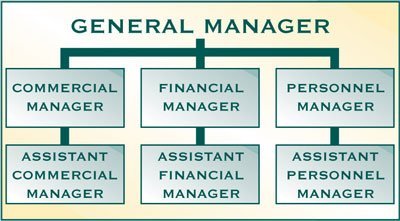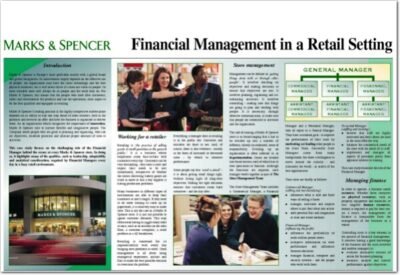
Marks & Spencer’s leading position in the highly competitive market-place depends on its ability to stay one step ahead of other retailers, both in the products and services on offer and how the business is organised to deliver them. As an organisation which recognises the importance of innovation, Marks & Spencer tries to nurture flexible and imaginative people. The Company needs people who are good at planning and organising, who can set objectives, establish priorities and allocate proper amounts of time to activities.
This case study focuses on the challenging role of the Financial Manager behind the scenes at every Marks & Spencer store. In doing so, it highlights many of the qualities, such as leadership, adaptability and analytical consideration, required by Financial Managers every day in a busy retail environment.
Working for a retailer
Retailing is ‘the practice of selling goods in small quantities to the general public.’ It is a business where employees come face-to-face with customers every day. Customers can be very demanding – they enter a store and expect their needs to be met immediately, irrespective of whether the lorries delivering bakery goods are stuck in snow or that a key supplier is having production problems.
Many businesses in different types of environment are able to keep their customers at arm’s length. If they need to do some training or catch up on paperwork, it is relatively easy to make time. This is not the case in a Marks & Spencer store. It is just not possible to ignore customer demands. This may often mean having to juggle many tasks at once, such as an accident on the sales floor, a customer complaint, a stock problem or a till breakdown.
Retailing is renowned for its unpredictability with every day bringing new problems to solve. Good management is all about using managerial experience, instinct and flair to make the best possible decision to overcome the problem. Everything a manager does in retailing is in the public eye. Successes and mistakes are there to see. And, of course, there is also evidence – usually in the form of increased or decreased sales – by which to measure performance.
Some people say that ‘retail is detail’ – it is about getting small things right, without losing sight of long-term objectives. Making the right decisions ensures that customers come back tomorrow – and the day after. This case study examines the role of the Financial Manager at Marks & Spencer.

Management can be defined as ‘getting things done with or through other people’. It involves deciding on objectives and making decisions to ensure that objectives are met. It involves planning, organising and coordinating activities. It involves controlling – making sure that things are going to plan and working with people. It is necessary, through effective communication, to make sure that people are committed to activities and the organisation.
The task of running a Marks & Spencer store is so broad-ranging that it has to be divided up into a number of different, closely co-ordinated, areas of responsibility. Dividing up an organisation is often referred to as departmentation. Stores are divided into broad sectors, each of which has its own specialism or function. Although the functions are separate, each manager works together as part of The Store Management Team.

Commercial Manager (selling and merchandising)
- influences what is sold and finds ways of selling it faster
- manages, motivates and inspires others to put their ideas into action
- adds personal flair and imagination to tried and tested methods.
Financial Manager (influencing the profit)
- influences the profitability of multi-million pound stores
- interprets information on store performance and influences business decisions
- manages financial, computer and security systems – and the people who work with them.
Personnel Manager (staffing and training)
- ensures that staff are highly motivated and their talents are used in the most effective way
- balances the commercial needs of the store with the needs of its staff
- implements and manages all aspects of personnel policy from appraisal systems to training.

Controlling costs is a key element in the process of financial management. It involves having a good knowledge of the business and the costs involved and enables managers to:
- evaluate alternative courses of action for business planning
- measure, analyse and control performance against objectives.
The Financial Manager
The Financial Manager has the most varied role of all the Store Management Team. In any one month, the Financial Manager could be dealing with issues as diverse as planning for new systems implementation, preparing and interpreting the quarterly profit statement to influence the priorities of the Management Team, or even working with other retailers and the Local Authority to help address current security issues. As a key player in the running of a store, or region of stores, the role of the Financial Manager is to develop ways of making the stores more profitable. The Financial Manager is responsible for providing timely and accurate data to manage each store.
Everything a Financial Manager does will have a direct impact on each store, although it is less immediately visible to the customer. They are actively involved in the day-to-day management of the store and need a good appreciation of all aspects of its operation. For example, in the same day, they may be looking at the financial implications of a new delivery schedule, discussing a new store development, thinking about the effects of opening on Sundays, as well as assessing the costs and benefits from the use of security cameras. It is important that the Financial Manager is able to discuss ideas, and using various methods of analysis, to make final recommendations on whether they will improve profitability and should therefore be implemented.
This type of practical, locally-based financial management is for people who are logical, analytical and business-minded. In a commercially-driven environment, they will need to be a financial advisor, systems expert, team-leader and retailer. Attention to detail on a day-to-day basis is important but they must also be a strategic thinker with the ability to plan ahead to shape the commercial direction of the business.

The forecast financial plan or budget for each store is known as the forecast profit and loss account. At the beginning of each year, the Management Team for each store will look back at the previous year’s sales and the targets/objectives for the whole organisation to predict their sales for the store for the following year. Anticipating what each store expects to achieve is particularly important as it takes account of local circumstances, such as the activities of competitors in the local shopping environment. For example, the opening of a large new shopping mall will influence the performance of other stores in the region.
The profit and loss account will also take into account controllable costs. These are locally-based costs on which the Management Team of each store can have an impact. They include staffing costs (number of staff to achieve sales targets), costs of refunds, lighting and gas costs, stationery costs, staff uniforms, as well as any other costs related to each store.
Producing a forecast profit and loss account enables each store to make comparisons with the activities of others. This is called benchmarking. It enables each store to assess its performance against the activities of ‘best-in-class’ similar stores. Making comparisons through the investigation of good practice and store performance is common practice at Marks & Spencer, enabling each store to learn and benefit from the good practice of others.
Marks & Spencer profit and loss template

The plan will also be reviewed by Financial Management at Head Office. For example, they might question certain figures or identify areas which might not have been considered by the Store Management Team, e.g. knowledge of a new system roll-out. Once the plan has been agreed, the Financial Manager’s role is to ensure that the store performs to the targets identified by the plan.

Making the store more profitable involves looking not just at the large direct costs but also examining the smaller indirect costs. (Savings in stationery in one store may be small, but across the whole Marks & Spencer Group, it may represent a considerable sum.)
Some costs are easier to control than others. For example, notices near light switches may be a simple way to save electricity by encouraging staff to turn off unnecessary lights. The use of stationery may simply be limited to the amount ordered. Costs such as theft and loss, however, may take up much more time, involving maximising the benefits of close-circuit television, using security guards efficiently to deter crime and deciding how to use store detectives. With around 35 tills in an average store, possibly being using by up to eight to ten staff each day and with large volumes of stock coming in at the back door, it will also involve close scrutiny of all areas of business organisation.
Line Manager
The Financial Manager is also a Line Manager with established responsibilities for decision-making. Every store has an administration office comprising a team of people dealing with expense-related issues. The team may be between 2 to 25 staff (depending on the size of store) and may include a Finance Supervisor reporting directly to either the Financial Manager or Assistant Financial Manager. The team will also be responsible for security staff.
The administration office is responsible for various information systems, such as Food Stock Management, Textile Ordering and Point-of-Sale information from the tills. Although staff across the store use these systems, reports from the systems will be extracted by the Financial Team for accounting purposes, for example, information from the tills provides key sales information which feeds into staffing costs. The Financial Manager will be consulted when problems arise with these systems and will take responsibility for decisions which have to be made. They will be responsible for data protection and computer security.
The team of managers within the store are not there all of the time, particularly when there is late opening. From time-to-time, therefore, the Financial Manager takes responsibility for the whole store, dealing with operational problems wherever they arise within the store, such as a customer problem, a distressed member of staff or a stock issue. The Financial Manager takes joint responsibility for legal requirements within the store, such as temperature issues, pricing issues, hygiene and waste disposal.
Problem solving
Problem solving is not just about day-to-day issues. It also involves understanding the complex relationship between variables so that the Financial Manager can respond flexibly to locally-based issues and problems as and when they arise. This may include feasibility issues, such as advising about the costs and benefits of working on Sundays, which may require considerable research and planning. The Financial Manager may also advise about general opening times.
Acting as an auditor
The Financial Manager acts as an internal auditor responsible for many different areas within each store. Every year, the store will be audited by the Company’s internal audit team from Head Office. The Financial Manager will therefore develop an audit trail for key issues which show the paperwork and procedures followed in responding to a particular problem to prove the integrity of the Company’s procedures.
The Financial Manager has a vital role which impacts directly on the activities of the Commercial and Personnel team. It is a very varied role, involved in every area of operation. Financial Managers are sometimes called the ‘conscience of the store’. Their work involves helping to develop better practices and improving the ways in which Marks & Spencer’s stores serve their customers.
 Working for sustainable development in primary industry (MP3)
Working for sustainable development in primary industry (MP3)  Financial management in a retail setting (PDF)
Financial management in a retail setting (PDF) 